When the GEIPAN turns 40, it is 40 years of emotions in the sky
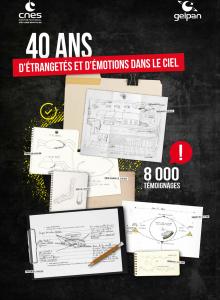
One or several witnesses are the starting point of a GEIPAN case. They have seen something that literally appears “out of the ordinary”, and they entrust GEIPAN about it :
- Yes, it is really bizarre… The witness does not understand what has been seen, it is puzzling and inexplicable. Whatever
the explanation that will be later given by the GEIPAN, initially it is really “extraordinary” for the witness - They entrust us by relating how it happened. It is never easy to talk about it…Can this person be considered mentally disturbed? The GEIPAN ensures complete anonymity for the witnesses.
The intensity of this lived experience is filling testimonies collected by the GEIPAN:
- In the written testimonies, “it was not a dream”, “I confirm that I do not drink”, “please, believe me”, “I do not sleep anymore” can frequently be found,
- The emotion of the witness is also perceivable from his/her voice during phone calls or in sketches that are often very
detailed.
The witness wants to give us all details, in order to increase the chance to get a feedback with a clear explanation.
During the last 40 years, 8000 testimonies were collected by the GEIPAN. It is mainly 4 decades of emotions in the sky.
For most of them, sightings are explained by the GEIPAN. It is its main mission.
But only some of them, when no objective explanation can be found, are drawing attention. Explanation issue for some, enigma, mystery or confirmation of various hypotheses for others, these unexplained cases draw attention of ordinary people, journalists and probably interest you, reader of these lines.
Contemporary weirdness in the sky is called flying saucers or UFOs since 1947
In June 1947, in the United States, private pilot Kenneth Arnold claimed that he saw a string of nine, shiny unidentified objects flying at high speed “like to saucers skipping on water”. Arnold's expression quickly led the press to use the term “flying saucer” not for describing the trajectory but for describing the object shape, whereas the Arnold descript the shape like a single flying wing or a boomerang ! Media’s impact already!
Then, in the US but also all over the word, a lot of sightings with high levels of weirdness occurred: the Washington D.C. 1952 incident (two nights during which US Air Force jet fighters chased unidentified lights and radar signals on the sky above the Capitol) or in France, the 1981 Trans-En-Provence case (a person witnessing a saucer landing and taking off from the edge of his garden and finding traces on the ground).
But the sky has been strange since the beginning of mankind
Human beings have always passionately observed the sky and numerous observations of celestial phenomena are mentioned in the most ancient writings or paintings of mankind.
And the science plays its role ... Weirdness can be transformed into known phenomena
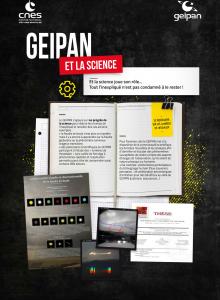
In 1803, Jean-Baptiste Biot visited the french village of L’Aigle, where “some stones fell from the sky”.
He made a report considered to be the first proof of the non-terrestrial origin of meteorites…
Since that time, we do know that a lot of ancient reports of frightening, bright lights in the sky correspond to meteoride crashes on earth. More recently, the intriguing ball lightning phenomena, along with some sightings of immobile or moving lights in the sky, found rational explanations.
Scientific expertise is one of the important aspect of the GEIPAN work: a group of experts of the each of the concerned scientific fields is working hand-to-hand with the GEIPAN, bringing a useful help for its investigations, but also benefiting from results from these investigations, whatever they are, to enlarge their own field of research.
Mission of the GEIPAN (« Groupe d’Etude et Information des Phénomènes Aérospatiaux Non-identifiés »)

Created in 1977 within the CNES:
- Provides a public and official feedback to all people’s “lived weirdness”
- Aims at explaining currently unexplained phenomena and improving the scientific knowledge.
Sighting reports and investigation conclusions are published on the GEIPAN website (www.geipan.fr) while maintaining the anonymity of witnesses.
GEIPAN is not an UFO expert. It is not a research organization aiming at identifying extraterrestrial life or advanced (or futuristic) technologies that may explain extraterrestrial visits.
In the GEIPAN vocabulary, the term “UFO” is not used and is replaced by PAN (for “Phénomènes Aérospatiaux Non-identifiés”) in French or UAP (“Unidentified Aerial Phenomena”) in English. The “UFO” term has two disadvantages: it defines an object (whereas what is seen is not always an object) and it has a meaning strongly associated with “flying saucer” or “alien”.
The GEIPAN is much more than a small department within the CNES: it is a national scheme
The Department includes 2 full-time CNES staff members (the head and his deputy) and a long-term sustained technical assistance (equivalent to 1.5 full-time staff member) for the management of documentation and the GEIPAN information system (database, website...).
Although low in human resources, it has proven to be sustainable. The ever-growing experience and expertise accumulated over the years has been not only necessary but also invaluable.
But the GEIPAN is not working alone:
- Collaborations with “Gendarmerie” and Police have been developed for the gathering of sightings and investigations,
- Around 20 volunteer investigators, selected and trained, are working for the GEIPAN and are present national-wide. They can rapidly visit a sighting location, meet with the witness and organize a reconstitution,
- Around fifteen scientific experts (plasma, meteorology, photos, psychology…) are involved on GEIPAN’s request and during regular expert meetings.
The GEIPAN department within the CNES is a small group of dedicated people who make work on a part-time base a large number of others people. Without the GEIPAN, the later would have worked locally and in a scattered way (“gendarmes” or volunteer investigators would have conducted investigations anyway). The main strength of the GEIPAN is to mutualize and to improve all experience and expertise national wide for one unique mission.
The GEIPAN is reporting to a steering committee consisting of the French institutions/organizations having issues linked to UAPs (gendarmerie, police, French department of Defence, French department of Civil Aviation, French national Meteorological department, public research organisms…).
The GEIPAN explains the weirdness and documents the unexplained
How can the weirdness perceived in a sighting be explained by one or several known phenomena? The most difficult phenomenon to explain can be:
- the one that initiated the sighting because there is always something in the sky, hoaxes being very rare:
- ball lightning, fall of a meteorite, night-club laser lights projecting toward the sky, orbital launcher degassing…or even Chinese lanterns ;
- and/or the one that, with a banal origin, will add weirdness to the sighting:
- wingless or stationary aircraft, holes in clouds in front of a red moon, moving star due to the autokinetic perception phenomenon…
These interdisciplinary (from physics to psychology) investigations are based on the actual scientific knowledge only (no explanations based on a future or hypothetical science). When no explanation is possible, the aim is to characterize the phenomena as well as possible before dissemination to science and researchers.
A recent revealing example: how a c-130 Hercules transport plane was taken for a flying saucer
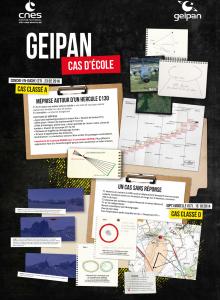
This case CONCHES-EN-OUCHE (27) 23.02.2016, involves four witnesses, three of them in a car driving on the road and the last one in a stationary car: Reports of the sighting include weirdness such as “like a stationary flying saucer emitting a cone of light” for the group of three or “a huge and slow triangle” for the fourth witness.
Quite rapidly, by using radar trace analysis, the GEIPAN is aware of the presence of a c-130 Hercules transport plane on the sighting location. Indeed, an agreement with the French Defence department CNOA (“Centre National des Opérations Aériennes”) allows the GEIPAN to have access to radar traces. But providing a feedback to witnesses to explain that they saw a plane is not enough, our mission is also to explain the perceived weirdness.
- For witnesses in the car, the illusion of a stationary UAP is due to a “pivot effect”: the witness and the phenomenon are both in movement and the axis between them is rotating around a point (or a particular zone) which gives the illusion to the witness to see a stationary phenomenon. The special lighting, here the indirect moonlight, is reflecting on the huge rounded airplane cabin and not on the wings (whose flatness favour the transient light reflexion more than the long-lasting one) creating by then a stationary saucer effect. The moon, low under horizon, enlighten the treetop creating a halo interpreted by the witnesses as a cone of light providing from the saucer.
- With its unusual size and lights, the plane is not recognized by the witness seated in the immobile car. The perception of a strange displacement is due to a perceptive mistake: one tends to evaluate the angular velocity by estimating the time taken by the plane’s tail to reach the position of the nose, leading to believe that a A380 is flying slower than a A320.
Complexity and fragility of the human testimony
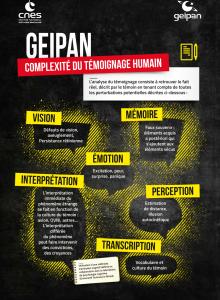
The GEIPAN always works from human testimonies. Most of the time a single one, sometimes several (witnesses can then be related to each other or not), including sometimes traces of the sightings: photos, radar traces, or more rarely some traces left by the phenomenon on the ground.
The analysis of what is reported by the witness is aiming at identifying what was really seen in a story that can be altered by factors from human origin such as :
- Vision deficiency;
- Perception mistakes due to the brain short-term processing (autokinetic effect) or due to psychological constructs (distance and speed of the UAP described by the witness, whereas it is clearly not possible to assess them from a non-recognized object, “pivot effect”, wrong reconstitution of the path);
- Identification and interpretation of the weirdness. Generally, the sighting is immediately and unconsciously transformed by the witness into a mix of what is really seen and a depiction of social and psychological representations made by the witness being the closest possible to what he/she knows and can identify. The less the sighting is easily identifiable and recognizable, the more cultural and social interpretations will be important in his/her testimony. Cultural differences will also be involved. When we meet the witness at distance from the sighting, the delayed interpretation can involve some opinions and beliefs;
- The emotion felt by the witnesses is one of the main factor that will increase the components described above and as a consequence will increase weirdness;
- Memory is of course involved, along with what is called “false memories” (memories acquired after the sighting and that will unconsciously be added to the lived memories);
- Culture of the witness will impact on the sighting report (the witness will use his/her own vocabulary).
The GEIPAN uses a cognitive interview developed by the Cognitive Psychology laboratory of Toulouse (http://clle.univ-tlse2.fr/) from the CNRS (« Centre National de la Recherche Scientifique »). This research team is working in this field by helping the police. The GEIPAN testimonies are very useful and a joint CNRS-CNES phD thesis was even sustained in order to better understand the “false memories “. Investigators are all trained to cognitive interview and apply it during their interactions with witnesses.
A classification methodology consolidated over decades

Since 2008, a more detailed classification (A/B/C/D1/D2) has been used by the GEIPAN. It is based on 2 main criteria: the weirdness and the consistency.
This methodology involves:
- The identification of research hypotheses that could explain the full weirdness of the sighting (as perceived by the witness) and the evaluation of their probability. Each hypothesis is based on one or several physical (such as stars or plasma) or psychological (such as perception effects, false memories) known phenomena;
- The characterisation of the sighting weirdness (E, ranging from 0 to 1). It is the distance to what is “known”, measured by the difference: 1 minus the probability of the strongest hypothesis. If the weirdness is above 0.5, the GEIPAN has no explanation (no hypothesis seems appropriate);
- The characterisation of the consistency of the sighting depending of the amount of gathered information (number of witnesses, number and precision of the responses, presence or not of photographic materials…) and its reliability (coherence, reliability of the witnesses, existing links between the different witnesses…).
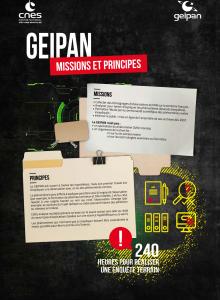
Finally, it requires to apply the following basic and common-sense principle: the more the weirdness is strong (i.e. the less the best hypothesis is probable), the more the consistency must be strong:
- to validate the “unexplained” when the weirdness is above 0.5. D1 (strange) or D2 (very strange) cases.
- to validate the explanation when the weirdness is below 0.5. A (almost proved hypothesis) or B (probable explanation) cases.
- otherwise, the sighting is declared “ not workable” due to lack of reliable data: C cases.
For D1 and D2 cases, on-site investigations, including a meeting with the witness and a cognitive interview, are systematically performed. Very often, the final classification is defined following the opinion of the group of experts. However, an eventual reclassification is always possible when a new element come in. The D cases need periodical re-evaluation
Explained and unexplained cases are equally interesting
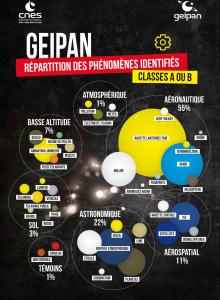
To understand the complexity of the human testimony, as we have inside what has been reported but also what (probably) happened;
- To understand the complexity of the human testimony, as we have inside what has been reported but also what (probably) happened;
- To understand the difficulty of the investigations; the border between an explained and an unexplained case can be tiny and sometimes depends of very few but decisive details;
- To improve the reliability of what is declared “unexplained”.
Remark: the unexplained can be of interest for basic physics, whereas explained cases could represent at least a similar or even a larger interest for the social sciences.
Pour comprendre la difficulté des investigations. Pour crédibiliser le caractère « non expliqué » des diagnostics. La frontière entre un cas expliqué est un cas inexpliqué peut tenir à quelques détails s’avérant clefs.
A lot has been published on “UFO mysteries” by writers who have worked only on unexplained cases, often without access to the source data of these cases and without knowledge or experience of explained cases.
Witnesses are ordinary people, coming from all social environments
Even the most experienced sky users can be caught by surprise. For example, pilots must report every odd OBSERVATION whether or not it impacts aerial security. However, it can be celestial bodies, a satellite falling back to earth or a meteorite entering in the earth atmosphere. Among the very odd unexplained cases, numerous ones are reported by aeronautical experienced sky users (pilots…).
Sometimes, witnesses try to justify the consistency of their sighting and their interpretation of what they have seen by their education level or by their professional expertise. Later on, they often are the most active in challenging or even denying the GEIPAN conclusions.
Statistics of the GEIPAN
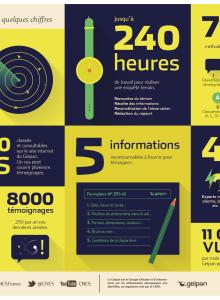
Across the last 40 years, 8000 testimonies (representing around 3000 cases) were analysed by the GEIPAN.
59 % of A and B cases are explained by some misidentification or by some perception mistake.
34 % of the sightings cannot be assess.
Around 7 % of the sightings remain unexplained.
Over the last decade, the rate of unexplained cases dropped to 2% with:
- a 3-fold increase in sightings, most of them with a low level of real weirdness (whereas the perceived weirdness can be strong);
- la définition cas D est plus stricte ;
- les enquêtes sont plus approfondies grâce aux outils numériques.
Today, the GEIPAN has sped up the reappraisal of old D cases with 50 of them re-investigated and explained in 2017.
Around 10% of the cases led to on-site investigations.
Globally, the GEIPAN is handling 500 requests per year: more than half are treated by an immediate feedback to the witness or by directing the witness towards others entities. Around 200 lead to investigations with diffusion on the GEIPAN website (www.geipan.fr) of sighting reports and investigation conclusions, maintaining anonymity of witnesses.
What to think about unexplained cases ? Why so many ?
Incompetency of the investigator ?
- Challenges encountered by the investigator are multiple: difficulty in defining or ranking the different hypotheses, no or low competency sharing between investigators, not involving the right expert. Most of the time, the most important challenge is to gather from the witness the key element that will explain the particular previously resisting to analysis. A lack of empathy, an insufficient ability to listen, a closed question or a question asked at the wrong moment, can definitively stop the opportunity to find an explanation;
Lack of investigation resources ?
- The GEIPAN resources are of course limited. An investigation can take up to 250 hours, but this remains rare. Old cases did not benefit from the now available powerful web-based and digital tools;
Hoaxes ?
- Very rare (< 1%) and we know how to detect them (but we do not disclose how).
Pathological liars ?
- We can also detect them. Expert psychologists are then involved and work using the questionnaire or audio recordings.
Hallucinations ?
- Sometimes it is obvious but in others cases, it can be difficult to detect. Hallucinations are not always pathological ones and can come from a witness whose behaviour and sayings rise no issue apart from the weirdness present in his/her sighting,. In this case, opinion of our expert psychologists will be decisive. They are then working from audio recordings made during the cognitive interview (authorized by the witnesses) or on-site by meeting the witnesses themselves.
Unknown natural phenomena ?
- We can hope that explanations will come from the future. Some phenomena have already been explained by the Science’s progress: ball lightning, autokinetic phenomenon. For sure, others will also find an explanation. Moreover, progress is also coming from the acquired experience: some of the explained cases (for witch objective proofs are available) allowed to identify and characterize what brought weirdness in these sightings. Such cases are nowadays much easier to identify and help to explain some recent or old cases that remain unexplained. For example, laser spotlight reflections in the sky, group of birds in flight formation, perception mistakes…).
Flying aircrafts from an unknown origin?
- Of course, this hypothesis cannot be excluded, although in 40 years of investigations of the GEIPAN, no proofs have been found.
And what about the alien hypothesis?
A large part of you, readers, is probably expecting some words on this matter. Having clearly said that the GEIPAN, to this day, has no proof of their existence, we will not formulate an opinion. An absence of proof does not make a proof of absence !
The alien hypothesis is constantly present in the work of the GEIPAN. It can be suggested or clearly expressed by the witness but also can only be present in his/her emotion in reaction to the sighting. Medias and journalists in particular have most of the time this aspect in mind during interviews, looking to find the best teaser or the best title for their paper. The GEIPAN’s work is also scrutinized and criticized by some UFO blogs and associations who are pros of the alien hypothesis..
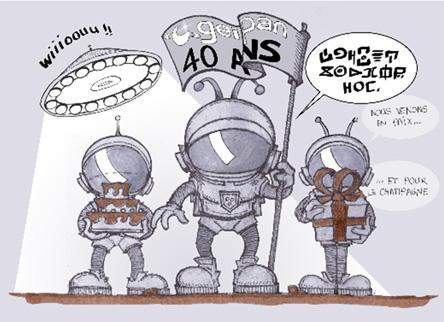
Not very far from the alien hypothesis stands the conspiracy theory which is also continuously present in the GEIPAN work: “the GEIPAN has been set up by the government to hide the truth”, “receives orders from the military”, etc…
All these theses must be managed by the GEIPAN in his daily work and clearly, GEIPAN respects all opinions and the need to believe.
Indeed, the fundamental question that may bring some weirdness in the sky at any time is of high nobleness : what place man has when facing the immensity of the universe?
FAQ GEIPAN
1. What is GEIPAN?
- GEIPAN (Group for the Study and Information of Unidentified Aerial/Aerospace Phenomena) is a technical department of the CNES (French Space Agency). Its mission is to collect, analyze, investigate, publish, and archive reports of UAP (Unidentified Aerial/Aerospace Phenomena) sightings.
- It also provides information and data to the public regarding UAPs and UFOs.
2. Is GEIPAN an independent structure?
- No, GEIPAN is a technical department of CNES (Centre National d’Études Spatiales), a public, industrial and commercial institute in charge of the definition and implementation of the French space policy. CNES operates under the supervision of the French government; Economy & Finance, Education & Research and the Defense Ministries
- GEIPAN is integrated within CNES as an expertise department.
3. Does GEIPAN carry out a national security or space surveillance mission?
- No. GEIPAN does not involve in a security topic nor a sky and space awareness or alert service.
- For any questions or alertsregarding your safety, please contact the appropriate authorities (police, gendarmerie, civil security, etc.).
4. Does GEIPAN research UFOs and extraterrestrial life?
- Contrary to popular belief, GEIPAN is not a research group on UFOs and extraterrestrial life, or other paranormal phenomena.
5. Does GEIPAN operate continuously?
- No. GEIPAN collects testimonies, analyzes the data, and then conducts an investigation using a multidisciplinary approach combining physical sciences and human factors.
- GEIPAN uses only recognized scientific knowledge, without speculation or unverified hypotheses.
- GEIPAN is not focused to respond immediately to requests related to UAP observations.
6. Does GEIPAN guarantee the confidentiality of testimonies?
- Yes. GEIPAN's mission is to publish its work while ensuring the anonymity of witnesses and the published documents linked to the investigation.
- Refer to the PRIVACY POLICY section regarding the protection of personal data collected for the purposes of investigations.
7. What is the methodology used?
GEIPAN follows a methodology summarized in seven key stages:
1. Receiving the testimony
2. Creating the file
3. Initial analysis
4. Investigation and processing
5. Classification into A, B, C, D
6. Anonymizing the files
7. witness information and publication
8. How does GEIPAN classify observation cases?
The classification process is done according a quantitative and qualitative assessment of two parameters: the consistency (C) of the observation and the residual strangeness (E) after investigation.
- Strangeness (E): This is the measure of the residual strangeness after comparison with known phenomena hypotheses.
- Consistency (C): This is the product of the quantity and the reliability of the data submitted and collected during the investigation. The objectivity of this data is weighted according to a specific table, part of the GEIPAN methodology.
Classification categories:
- Classification A: Phenomenon perfectly identified after investigation.
- Classification B: Phenomenon probably identified after investigation.
- Classification C: Phenomenon not identified due to lack of data or information.
- Classification D: Phenomenon not identified after investigation.
A revisit process, or a new analysis, of cases C and D may be conducted if new information related to these cases is communicated to GEIPAN after the initial investigation.
9. Who can testify?
- Anyone can provide testimony.
- GEIPAN is not sized to respond to indirect witness(es) of an UAP observation (i.e. reported by third parties).
- Testimony from minor witness is subject to parental authorization.
10. What is the place of human testimony in the investigation?
- Human testimony is at the core of the process and methodology for GEIPAN.
- GEIPAN only investigates phenomena reported by one or more direct witnesses of the observation.
- The witness must fulfil the technical questionnaire (QT), designed to gather the essential and substantial information to open an investigation.
- Visual, material or detection matters such as sketches, photographs, videos, etc. may complete the QT.

